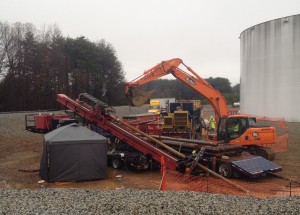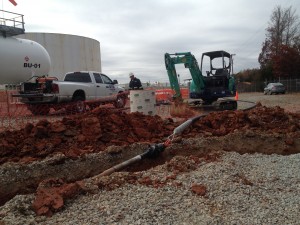Biosparge Well Installation Beneath a Petroleum Tank Farm
In early 2014 DTD completed the installation of two biosparge wells in the southeastern United States. These wells are designed to remediate a contaminated groundwater plume created by two separate fuel releases from a fuel tank farm. The wells were constructed of 4-inch HDPE and installed single-ended (blind completion). Each well was approximately 900-feet long, 70-feet below grade, and drilled beneath fuel storage tanks (1,000,000 gallon) and an active fueling terminal.
The site infrastructure (tanks, pipeline, etc.) prevented navigation with standard walkover locating technology, and further site restrictions prevented use of a surface wireline coil, so an alternate approach was needed. With no other viable alternative, DTD turned to a Gyroscopic Steering Tool (GST) for navigation. The GST is placed behind the drill bit and is powered by a wireline through the drill string. This inside-the-drill string inertial navigation system allows accurate locating without any other input (i.e., surface coil). The GST locating system used for this project allowed the drill operator to advance precise borepaths, meeting the tight tolerances requested by the client.
Site geology consisted of clay overlying saprolite, that graded into unweathered granite. These conditions and the bore lengths required our 90,000 lb class drill rig running a mud motor to advance the bores. While drilling the harder granitic rock, one of the bores passed in and out of highly weathered zones including sand and gravel. These gravel zones created a pathway for drilling fluid to migrate away from the bore and eventually to the ground surface. The mud returning to the ground surface required vacuum trucks and additional personnel to contain the inadvertent returns. In total, approximately xxxxx gallons of fluids were reclaimed from the ground surface, slowing the process by a day or two, but not preventing the successful installation.
After the wells were completed, each was connected by 3-inch conduit to the new treatment building outside the secondary containment. This required a series of trenches and bores going between the wells, beneath the containment dike, and to the treatment building. DTD completed this effort with a mini-excavator and second smaller HDD rig.

